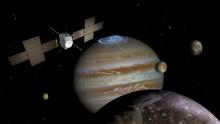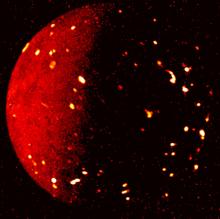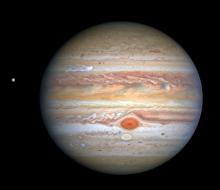Listen to today's episode of StarDate on the web the same day it airs in high-quality streaming audio without any extra ads or announcements. Choose a $8 one-month pass, or listen every day for a year for just $30.
You are here
Moon and Planets
The average surface temperature on Io, one of the big moons of Jupiter, is a couple of hundred degrees below zero. That’s a little surprising, though, when you consider Io’s claim to fame: It’s the most volcanically active body in the solar system.
Io is covered by more than 400 active volcanoes. Some of them blast plumes of gas and dust hundreds of miles high. Others produce lakes of molten rock. The temperatures of these pools can top 2,000 degrees Fahrenheit.
The heat doesn’t get spread to the rest of the surface, though, because Io has almost no atmosphere. Scientists have detected some wisps of sulfur, but they would qualify as a hard vacuum here on Earth. And what little atmosphere there is freezes out when Io passes through Jupiter’s wide shadow.
Io is heated by an eternal tug of war between Jupiter and a couple of its other large moons. The moons pull Io into a slightly lopsided orbit. That causes Jupiter’s gravity to squeeze and stretch the moon like a child playing with a Nerf ball. That heats Io’s interior, creating reservoirs of molten sulfur and other compounds. Some of that lava punches through to the surface, creating the hellish landscape on this distant moon.
And Jupiter is near our own moon at first light tomorrow. It looks like a bright star to the lower left of the Moon. The brighter planet Venus — the “morning star” — is farther along the same line.
More about Venus and the Moon tomorrow.
Script by Damond Benningfield





